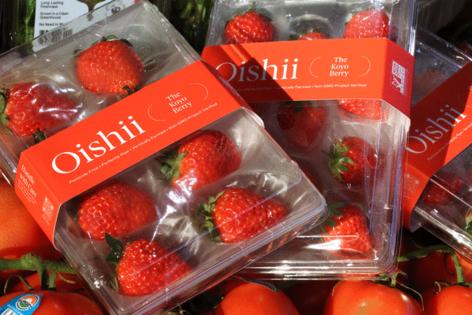Are Oishii strawberries worth it?
Published in Variety Menu
CHICAGO -- There isn’t a more perpetually disappointing fruit than a grocery store strawberry. And it’s truly hard not to get catfished by strawberries because even the most sour ones look beautiful on the outside.
In the U.S., where many strawberries are picked before they’re fully ripe so they can withstand transportation and are typically shipped before they reach full sweetness, consumers don’t have much in terms of an alternative, making it easier to accept the vicious cycle of buying a carton of Driscoll’s, eating a few and then thinking of what to do with the rest as they collect fuzz a mere three days later.
Hiroki Koga, co-founder and CEO of New Jersey-based Oishii, hopes his vertical farming company with Japanese roots will show American consumers what a first-rate strawberry tastes like.
“Our berries last longer, they’re fresher, they’re pesticide free, but most importantly, they contain two to three times more sweetness compared to your traditional berries,” Koga said over the phone. “So unless you’ve traveled to Japan and had really high-quality strawberries, this is going to be nothing like what you usually find in the regular supermarkets (in America).”
Koga’s team has been busy promoting the “Koyo Berries” for Oishii’s recent Chicagoland rollout. Oishii has been creeping into the American market slowly since 2018, starting with New York City, and arrived in Chicago on Oct. 2 at select local Whole Foods, where they’ll be available year-round since the berries are always in season.
While Oishii’s strawberries are grown in New Jersey, the vertical farm mimics the optimal growing environment of the Japanese Alps: soft rain, mild heat, warm light and buzzing bees.
Koga said Oishii unveiled a new vertical farm space in June, and the company was able to achieve the right conditions by coupling technology and the precision of centuries-old Japanese farming techniques.
The Amatelas Farm, named after the mythical Japanese sun goddess, is located next to a massive solar field, uses robots that analyze 60 billion data points annually and help harvest the strawberries at peak ripeness, Koga said. Other machines monitor temperature, humidity, carbon dioxide, wind speed and light to replicate the perfect growing conditions of Japan to produce two kinds of berries so far — the Omakase and the Koyo.
The Koyo, available locally at Whole Foods, is $10 for a 4-ounce package that holds about eight strawberries. The even pricier Omakase berries are not yet for sale retail in Chicago, but have dropped from $50 to $12 a tray, Koga said.
For the recent rollout, Oishii partnered with Sawada coffee shop for a limited time in early October to make the Oishii Matcha Latte and the Oishii Mocha using Koyo and Omakase berries. Until the end of the month, Omakase Yume’s tasting menu will include an Oishii Matcha Panna Cotta, an Oishii Berry Shooter and an Omakase Berry spritz.
“We wanted a deep strawberry flavor in the drinks, so we created a rich strawberry syrup using the Koyo Berries,” said Hiroshi Sawada, owner and barista master at the West Loop coffee shop. “The only ingredients in this syrup are the berries and a little sugar — not even water. The syrup has a vibrant, pure, bold strawberry flavor.”
Sawada noted that the vibrant, juicy flavor of the Koyo Berries, reminiscent of strawberries in Japan, pairs perfectly with the shop’s earthy, herbal matcha.
Koyo means “elated” in Japanese, and Koga said the variety is intended to have a slightly firmer texture than a regular strawberry, as well as a bright aroma.
“Out of the 500 commercial strawberry varieties available on earth, more than half of them come from Japan, and those are your higher-quality strawberries. So as a country, we’ve been doing this for the last 30 to 40 years,” Koga explained. “I came to realize that there’s a huge difference in the quality of produce that was available in the U.S. and I wanted to be able to share my culture as well as benefit the US customers.”
Koga didn’t necessarily see overnight success or even much attention. In the early days of 2018, he had to quite literally knock on doors.
“So before we even started the business, we imported very high-quality Japanese strawberries, similar to the level that we’re currently growing on the farm, and we had to test the market to see if there was any appetite, right?” Koga explained. “So, we knocked on the doors of Michelin-star restaurants for about a full week, and we got a phenomenal reaction.”
Koga offered samples priced at $6 per strawberry to some of New York City’s big-name restaurants. And the kicker is that he sold out.
“Some of the chefs were like, ‘I’ve never had anything like this before. … Can you actually start distributing from tomorrow?’” Koga said with a laugh. “Then slowly, we started working on this venture. And when we got our first harvest, we took it to Chef’s Table at Brooklyn Fair and the head chef, Cesar Ramirez, said he wants to use it from the next day. That was the first sale we ever made as a company.”
Koga said the strawberry was featured on the restaurant’s tasting menu as the last bite, then even more restaurants wanted in. As designer produce often does, the strawberries started going viral as diners took to social media to record their first bites.
Soon everyday consumers got wind of the berries, too. Whenever Koga had an excess supply, he’d open up an online waiting list for short-notice drops.
“People would pay $50 to get a tray and we had thousands of people on the waitlist,” Koga said. “It’s still not the cheapest strawberry now, but it’s much, much more affordable and the goal is to keep on innovating and making this even more available and accessible,” he said.
Koga, who lived in the Chicago area during a consulting stint in 2012, said he’s excited to see his berries flourish in a city that has such a unique culinary footprint.
Koga said he’s looking forward to more “reaction videos” on social media as the strawberries gain even more steam. In some reactions, food bloggers and home cooks are seen biting into a strawberry and questioning whether or not it’s real.
“If people can’t believe that this is a naturally grown product because it’s just so different from what they’re used to eating, that’s always a good thing,” Koga laughed.
We tried the Koyo Berries
I buy at least three cartons of strawberries a month — usually Driscoll’s or whatever’s on sale at Jewel, because I have a 1-year-old and no one loves strawberries more than babies love strawberries. So I was extra curious to try Oishii’s Koyo Berries and compare them with the strawberries sitting in my fridge.
That first bite was immediately better than any strawberry I’ve had, with the only exception being the strawberries I tasted when we visited Japan in April. Produce and fruit in Japan are immaculate and something I miss often, so while eight strawberries for $10 is expensive and a bit out of touch with reality, it isn’t a gimmick.
The meticulous non-GMO, pesticide-free process does actually result in strawberries that are completely absent of a sour taste. You might be thinking: OK, you mean they’re sweet?
Not sure how to explain it other than that there isn’t even a tinge of sour. A tiny tart undertone, maybe, but every bite is just sweet and flavorful.
The berries are marketed more as an experience than just a fruit. A postcard that comes with the box suggests how best to enjoy them. Refrigerate until ready to eat, but rest the berries at room temperature for 10 to 15 minutes before tasting. “Breathe in the bright fragrance,” the card says. “Allow the aroma to fill the room.” Lastly, “close your eyes, take a bite.”
I didn’t close my eyes, but I did take a sniff. Smelled a bit like strawberry candy.
Would I pay $10 for eight strawberries? If I saw them at Whole Foods having no prior knowledge of the backstory, I probably would not. But having talked at length with Koga about the unmatched quality of the strawberries given their Japanese origin, I definitely would buy again, just maybe not at the volume of which I buy regular ones.
Like Koga, I now believe that the magic of a perfect strawberry exists in America, too. You just have to be willing to pay for what a strawberry could be.
©2024 Chicago Tribune. Visit at chicagotribune.com. Distributed by Tribune Content Agency, LLC.










Comments